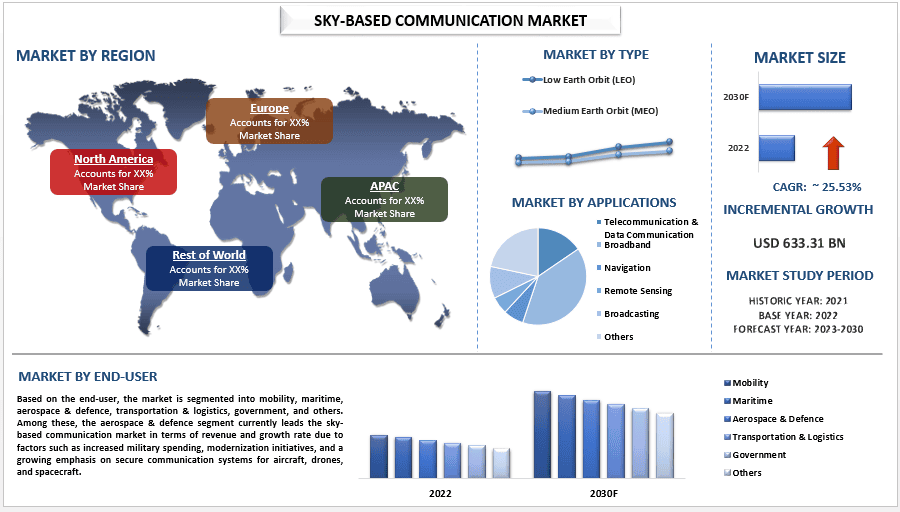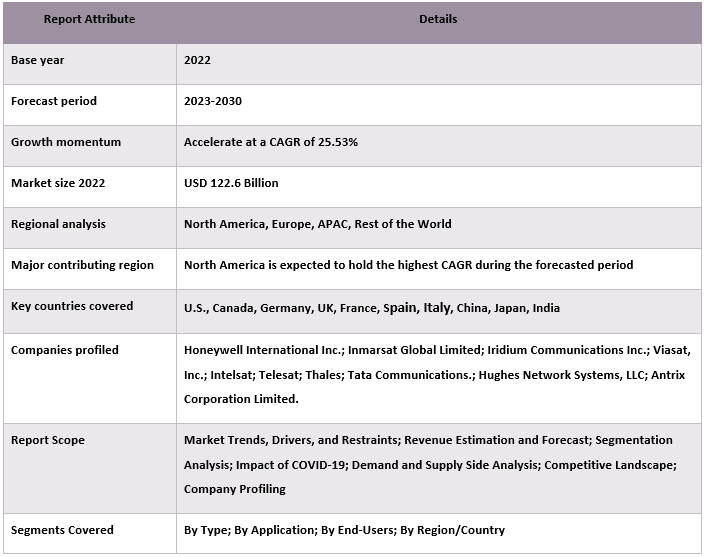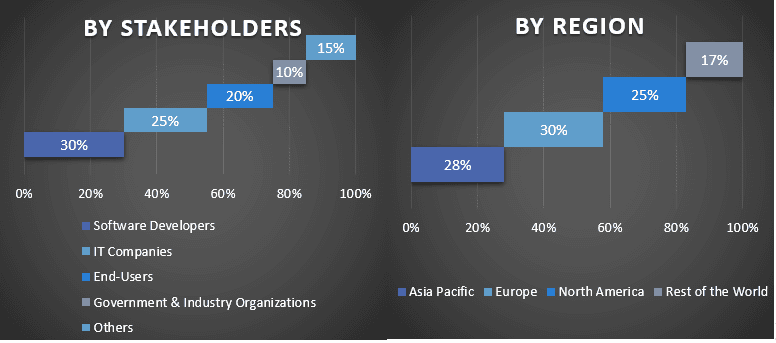- Trang chủ
- Về chúng tôi
- Ngành
- Dịch vụ
- Đọc
- Liên hệ với chúng tôi
Thị trường Truyền thông Trên không: Phân tích Hiện tại và Dự báo (2023-2030)
Nhấn mạnh vào Loại (Quỹ đạo Trái Đất Thấp (LEO), Quỹ đạo Trái Đất Trung bình (MEO)); Ứng dụng (Viễn thông & Truyền thông Dữ liệu, Băng thông rộng, Định vị, Viễn thám, Phát sóng và Các loại khác); Người dùng cuối (Tính di động, Hàng hải, Hàng không vũ trụ & Quốc phòng, Vận tải & Logistics, Chính phủ và Các loại khác) và Khu vực/Quốc gia.

Thị trường Truyền thông trên Không gian trị giá 122,6 tỷ đô la vào năm 2022 và dự kiến sẽ tăng trưởng với tốc độ ổn định khoảng 25,53% trong giai đoạn dự báo (2023-2030) do nhu cầu ngày càng tăng về khám phá không gian và các ứng dụng quân sự đã dẫn đến sự gia tăng đáng kể về sự quan tâm và đầu tư vào các hệ thống truyền thông trên không gian. Truyền thông trên không gian đề cập đến việc sử dụng các vệ tinh trong không gian để cung cấp các dịch vụ viễn thông như truy cập internet, cuộc gọi thoại và các truyền dữ liệu khác. Thị trường truyền thông trên không gian đã phát triển nhanh chóng trong những năm gần đây do nhu cầu ngày càng tăng về kết nối tốc độ cao trên toàn cầu, đặc biệt ở những khu vực xa xôi nơi cơ sở hạ tầng truyền thống có thể không có sẵn hoặc không thực tế. Hơn nữa, sự phát triển của các công nghệ mới, chẳng hạn như IoT và AI, đã mở ra những cơ hội mới cho truyền thông vệ tinh, làm cho nó phù hợp và linh hoạt hơn cho nhiều ứng dụng khác nhau. Ngoài ra, số lượng vệ tinh được phóng lên vì mục đích liên lạc ngày càng tăng đã góp phần vào sự tăng trưởng của thị trường truyền thông trên không gian, vì càng có nhiều vệ tinh trên quỹ đạo thì nhu cầu về các hệ thống và dịch vụ liên lạc càng tăng. Ví dụ, theo Văn phòng Liên hợp quốc về các vấn đề không gian vũ trụ, số lượng vật thể được Hoa Kỳ phóng vào vũ trụ hàng năm vào năm 2023 ước tính là 2.166.
Một số nhà sản xuất lớn hoạt động trên thị trường bao gồm Honeywell International Inc.; Inmarsat Global Limited; Iridium Communications Inc.; Viasat, Inc.; Intelsat; Telesat; Thales; Tata Communications.; Hughes Network Systems, LLC; Antrix Corporation Limited.
Những thông tin chi tiết được trình bày trong Báo cáo
“Trong số các loại, phân khúc MEO chiếm thị phần lớn nhất trên thị trường trong giai đoạn dự báo.”
Dựa trên loại, thị trường được chia thành quỹ đạo thấp (LEO), quỹ đạo trung bình (MEO). Trong số này, phân khúc MEO đang phát triển nhanh chóng. Sự tăng trưởng này chủ yếu được thúc đẩy bởi các yếu tố như nhu cầu ngày càng tăng về kết nối internet tốc độ cao, việc áp dụng ngày càng nhiều các dịch vụ dựa trên vệ tinh ở các khu vực xa xôi và những tiến bộ trong công nghệ MEO cho phép sử dụng hiệu quả hơn phổ tần khả dụng. Vệ tinh LEO có độ trễ thấp hơn nhưng chi phí trên mỗi bit cao hơn, trong khi vệ tinh MEO mang lại hiệu quả chi phí tốt hơn nhưng độ trễ cao hơn một chút. Do đó, các hệ thống MEO đã trở nên phổ biến trong số các công ty viễn thông và cơ quan chính phủ do sự cân bằng giữa hiệu suất và khả năng chi trả.
“Trong số các ứng dụng, phân khúc viễn thông & truyền dữ liệu chiếm tỷ trọng đáng kể trong giai đoạn dự báo.”
Dựa trên ứng dụng, thị trường được phân loại thành viễn thông & truyền dữ liệu, băng thông rộng, điều hướng, viễn thám, phát sóng và các ứng dụng khác. Trong số này, phân khúc viễn thông & truyền dữ liệu đã thống trị thị trường truyền thông trên không gian về mặt tăng trưởng và áp dụng. Bao gồm các dịch vụ dựa trên vệ tinh như truyền thông di động, kết nối internet và các hình thức truyền kỹ thuật số khác bằng vệ tinh. Nhu cầu ngày càng tăng về truy cập internet tốc độ cao và mạng truyền thông đáng tin cậy đã thúc đẩy sự tăng trưởng của phân khúc này. Tuy nhiên, các phân khúc khác như viễn thám và điều hướng cũng đã chứng kiến sự phát triển đáng kể và có tiềm năng cho sự mở rộng trong tương lai.
“Bắc Mỹ sẽ chiếm một thị phần đáng kể trên thị trường.”
Bắc Mỹ dự kiến sẽ thống trị thị trường truyền thông trên không gian, với Hoa Kỳ đóng vai trò quan trọng trong việc thúc đẩy sự tăng trưởng của thị trường. Các chương trình không gian và quân sự đang phát triển, sự phát triển công nghệ, nhu cầu thị trường, các khoản đầu tư chiến lược và các phân khúc tăng trưởng cao của khu vực đã đóng góp chung vào vị trí dẫn đầu của khu vực này trên thị trường. Thị trường truyền thông trên không gian được thúc đẩy bởi một số yếu tố, bao gồm những tiến bộ công nghệ, nhu cầu ngày càng tăng về khám phá không gian và nhu cầu về kết nối tốc độ cao ở các khu vực xa xôi.
Phạm vi Báo cáo Thị trường Truyền thông trên Không gian

Lý do nên mua báo cáo này:
- Nghiên cứu bao gồm phân tích kích thước và dự báo thị trường được xác thực bởi các chuyên gia hàng đầu trong ngành được xác thực.
- Báo cáo trình bày một đánh giá nhanh về hiệu suất tổng thể của ngành trong nháy mắt.
- Báo cáo bao gồm phân tích chuyên sâu về các đối thủ trong ngành nổi bật với trọng tâm chính vào các số liệu tài chính kinh doanh chính, danh mục sản phẩm, chiến lược mở rộng và những phát triển gần đây.
- Xem xét chi tiết các động lực, hạn chế, xu hướng chính và cơ hội đang thịnh hành trong ngành.
- Nghiên cứu bao gồm toàn diện thị trường trên các phân khúc khác nhau.
- Phân tích sâu về ngành ở cấp độ khu vực.
Tùy chọn tùy chỉnh:
Thị trường Truyền thông trên Không gian toàn cầu có thể được tùy chỉnh thêm theo yêu cầu hoặc bất kỳ phân khúc thị trường nào khác. Bên cạnh đó, UMI hiểu rằng bạn có thể có nhu cầu kinh doanh riêng, vì vậy vui lòng liên hệ với chúng tôi để nhận được một báo cáo hoàn toàn phù hợp với yêu cầu của bạn.
Mục lục
Phương Pháp Nghiên Cứu Phân Tích Thị Trường Truyền Thông Trên Không
(2023-2030)
Phân tích thị trường lịch sử, ước tính thị trường hiện tại và dự báo thị trường tương lai của thị trường Truyền thông Trên không toàn cầu là ba bước chính được thực hiện để tạo và phân tích việc áp dụng thị trường Truyền thông Trên không ở các khu vực lớn trên toàn cầu. Nghiên cứu thứ cấp toàn diện đã được thực hiện để thu thập số liệu thị trường lịch sử và ước tính quy mô thị trường hiện tại. Thứ hai, để xác thực những thông tin chi tiết này, nhiều phát hiện và giả định đã được xem xét. Hơn nữa, các cuộc phỏng vấn sơ cấp chuyên sâu cũng được thực hiện với các chuyên gia trong ngành trên toàn bộ chuỗi giá trị của thị trường Truyền thông Trên không toàn cầu. Sau khi giả định và xác thực số liệu thị trường thông qua các cuộc phỏng vấn sơ cấp, chúng tôi đã sử dụng phương pháp tiếp cận từ trên xuống/từ dưới lên để dự báo quy mô thị trường hoàn chỉnh. Sau đó, các phương pháp phân tích chi tiết thị trường và phương pháp đo đạc dữ liệu được áp dụng để ước tính và phân tích quy mô thị trường của các phân khúc và phân đoạn phụ của ngành có liên quan. Phương pháp luận chi tiết được giải thích dưới đây:
Phân Tích Quy Mô Thị Trường Lịch Sử
Bước 1: Nghiên Cứu Chuyên Sâu Các Nguồn Thứ Cấp:
Nghiên cứu thứ cấp chi tiết đã được thực hiện để có được quy mô thị trường lịch sử của thị trường Truyền thông Trên không thông qua các nguồn nội bộ của công ty như báo cáo thường niên & báo cáo tài chính, thuyết trình hiệu suất, thông cáo báo chí, v.v., và các nguồn bên ngoài bao gồm tạp chí, tin tức & bài báo, ấn phẩm của chính phủ, ấn phẩm của đối thủ cạnh tranh, báo cáo ngành, cơ sở dữ liệu của bên thứ ba và các ấn phẩm đáng tin cậy khác.
Bước 2: Phân Khúc Thị Trường:
Sau khi có được quy mô thị trường lịch sử của thị trường Truyền thông Trên không, chúng tôi đã tiến hành phân tích thứ cấp chi tiết để thu thập thông tin chi tiết về thị trường lịch sử và chia sẻ cho các phân khúc & phân đoạn phụ khác nhau cho các khu vực lớn. Các phân khúc chính được bao gồm trong báo cáo là loại, ứng dụng và người dùng cuối. Phân tích sâu hơn ở cấp quốc gia đã được tiến hành để đánh giá việc áp dụng tổng thể các mô hình thử nghiệm ở khu vực đó.
Bước 3: Phân Tích Yếu Tố:
Sau khi thu thập được quy mô thị trường lịch sử của các phân khúc và phân đoạn phụ khác nhau, chúng tôi đã tiến hành phân tích yếu tố chi tiết để ước tính quy mô thị trường hiện tại của thị trường Truyền thông Trên không. Hơn nữa, chúng tôi đã tiến hành phân tích yếu tố bằng cách sử dụng các biến phụ thuộc và độc lập như các loại, ứng dụng và người dùng cuối khác nhau của thị trường Truyền thông Trên không. Một phân tích kỹ lưỡng đã được tiến hành về các kịch bản cung và cầu có xét đến các quan hệ đối tác hàng đầu, sáp nhập và mua lại, mở rộng kinh doanh và ra mắt sản phẩm trong lĩnh vực thị trường Truyền thông Trên không trên toàn cầu.
Ước Tính & Dự Báo Quy Mô Thị Trường Hiện Tại
Định cỡ Thị trường Hiện tại: Dựa trên những thông tin chi tiết hữu ích từ 3 bước trên, chúng tôi đã xác định được quy mô thị trường hiện tại, những người chơi chính trong thị trường Truyền thông Trên không toàn cầu và thị phần của các phân khúc. Tất cả các tỷ lệ phần trăm chia sẻ, và phân tích chi tiết thị trường cần thiết đã được xác định bằng cách sử dụng phương pháp thứ cấp nói trên và đã được xác minh thông qua các cuộc phỏng vấn sơ cấp.
Ước tính & Dự báo: Để ước tính và dự báo thị trường, trọng số đã được gán cho các yếu tố khác nhau bao gồm động lực & xu hướng, hạn chế và cơ hội có sẵn cho các bên liên quan. Sau khi phân tích các yếu tố này, các kỹ thuật dự báo liên quan, tức là phương pháp tiếp cận từ trên xuống/từ dưới lên đã được áp dụng để đưa ra dự báo thị trường cho năm 2030 cho các phân khúc và phân đoạn phụ khác nhau trên các thị trường lớn trên toàn cầu. Phương pháp nghiên cứu được áp dụng để ước tính quy mô thị trường bao gồm:
- Quy mô thị trường của ngành, về doanh thu (USD) và tỷ lệ chấp nhận của thị trường Truyền thông Trên không trên các thị trường lớn trong nước
- Tất cả các tỷ lệ phần trăm chia sẻ, phân tách và phân tích chi tiết của các phân khúc và phân đoạn phụ của thị trường
- Những người chơi chính trong thị trường Truyền thông Trên không toàn cầu về các sản phẩm được cung cấp. Ngoài ra, các chiến lược tăng trưởng được các nhà sản xuất này áp dụng để cạnh tranh trong thị trường đang phát triển nhanh chóng.
Xác Thực Quy Mô Thị Trường và Thị Phần
Nghiên Cứu Sơ Cấp: Các cuộc phỏng vấn chuyên sâu đã được thực hiện với các Nhà Lãnh Đạo Tư Tưởng Chủ Chốt (KOL) bao gồm các Giám đốc Điều hành Cấp Cao (CXO/VP, Trưởng Phòng Kinh Doanh, Trưởng Phòng Marketing, Trưởng Phòng Vận Hành, Trưởng Khu Vực, Trưởng Quốc Gia, v.v.) trên khắp các khu vực lớn. Các phát hiện nghiên cứu sơ cấp sau đó đã được tóm tắt và phân tích thống kê đã được thực hiện để chứng minh giả thuyết đã nêu. Thông tin đầu vào từ nghiên cứu sơ cấp đã được hợp nhất với các phát hiện thứ cấp, do đó biến thông tin thành thông tin chi tiết hữu ích.
Phân Chia Người Tham Gia Nghiên Cứu Sơ Cấp ở Các Khu Vực Khác Nhau

Kỹ Thuật Thị Trường
Kỹ thuật đo đạc dữ liệu đã được sử dụng để hoàn thành việc ước tính thị trường tổng thể và đưa ra các số liệu thống kê chính xác cho từng phân khúc và phân đoạn phụ của thị trường Truyền thông Trên không toàn cầu. Dữ liệu được chia thành nhiều phân khúc & phân đoạn phụ sau khi nghiên cứu các thông số và xu hướng khác nhau trong các lĩnh vực loại, ứng dụng và người dùng cuối trong thị trường Truyền thông Trên không toàn cầu.
Mục tiêu chính của Nghiên cứu Thị trường Truyền thông Trên không Toàn cầu
Các xu hướng thị trường hiện tại & tương lai của thị trường Truyền thông Trên không toàn cầu đã được xác định chính xác trong nghiên cứu. Các nhà đầu tư có thể thu được những hiểu biết sâu sắc mang tính chiến lược để làm cơ sở cho quyết định đầu tư của họ dựa trên phân tích định tính và định lượng được thực hiện trong nghiên cứu. Các xu hướng thị trường hiện tại và tương lai đã xác định sức hấp dẫn tổng thể của thị trường ở cấp khu vực, cung cấp một nền tảng cho người tham gia công nghiệp khai thác thị trường chưa được khai thác để hưởng lợi từ lợi thế của người đi đầu. Các mục tiêu định lượng khác của nghiên cứu bao gồm:
- Phân tích quy mô thị trường hiện tại và dự báo của thị trường Truyền thông Trên không về giá trị (USD). Ngoài ra, hãy phân tích quy mô thị trường hiện tại và dự báo của các phân khúc và phân đoạn phụ khác nhau.
- Các phân khúc trong nghiên cứu bao gồm các lĩnh vực loại, ứng dụng và người dùng cuối.
- Xác định và phân tích khuôn khổ pháp lý cho ngành thị trường Truyền thông Trên không.
- Phân tích chuỗi giá trị liên quan đến sự hiện diện của các trung gian khác nhau, cùng với việc phân tích hành vi của khách hàng và đối thủ cạnh tranh trong ngành.
- Phân tích quy mô thị trường hiện tại và dự báo của thị trường Truyền thông Trên không cho khu vực lớn.
- Các quốc gia lớn trong khu vực được nghiên cứu trong báo cáo bao gồm Châu Á Thái Bình Dương, Châu Âu, Bắc Mỹ và Phần còn lại của Thế giới.
- Hồ sơ công ty của thị trường Truyền thông Trên không và các chiến lược tăng trưởng được các nhà sản xuất trên thị trường áp dụng để duy trì trong thị trường đang phát triển nhanh chóng.
- Phân tích chuyên sâu ở cấp khu vực về ngành
Câu hỏi thường gặp Câu hỏi thường gặp
Câu hỏi 1: Quy mô thị trường hiện tại và tiềm năng tăng trưởng của thị trường Truyền thông Dựa trên Bầu trời toàn cầu là gì?
Câu hỏi 2: Đâu là những yếu tố thúc đẩy sự tăng trưởng của thị trường Truyền thông Dựa trên Bầu trời toàn cầu?
Q3: Phân khúc nào chiếm thị phần lớn nhất trong thị trường Truyền thông trên không toàn cầu theo Người dùng cuối?
Q4: Khu vực nào sẽ chiếm lĩnh Thị trường Truyền thông trên Không gian toàn cầu?
Q5: Ai là những người chơi chủ chốt hoạt động trong Thị trường Truyền thông trên Không gian Toàn cầu?
Liên quan Báo cáo
Khách hàng đã mua mặt hàng này cũng đã mua










